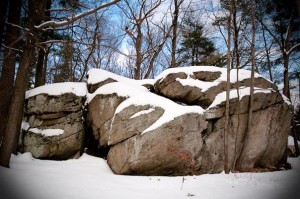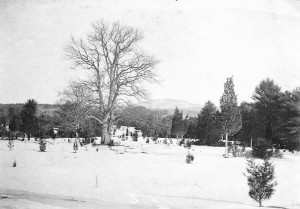A Cave to Remember
By George T. ComeauI was intrigued the day I opened the email from my good friend and fellow historian Dave Lambert. Lambert is one of the town of Stoughton’s preeminent local historians, and since Canton was once part of Stoughton, he shares my passion for all things related to the history of our two sibling communities.
 The email arrived in early January 2009. The body of the email was simple and read: “Here are the images of Fairbanks Cave in 1908, and the location in 2009. Want to go on an adventure; let me know!”
The email arrived in early January 2009. The body of the email was simple and read: “Here are the images of Fairbanks Cave in 1908, and the location in 2009. Want to go on an adventure; let me know!”
An adventure? “Yes” always was my answer. After all, I assume, dear reader, that you saw my last installment on the subject of trespassing. The very idea of a “cave” in Canton was more than I could hope for. The email contained the map illustrated with this story.
Old maps are not new to Canton. The “Histy” has dozens upon dozens. Nestled in banker’s boxes, on the shelf above the vault door, hanging on walls, in flat files, and just about everywhere throughout the building. In fact, several similar maps to the one that Lambert sent me are in a small metal drawer just inside the Historical Society vault. Some of the maps are so old and creased that great care must be taken with simply unrolling the vellum.
It turns out that actually finding this cave would be harder than it seemed. Canton has changed so much in a hundred years. The landscape has been bulldozed, filled, excavated, and man has dominated the natural form such that little unprotected and untouched open space remains. A cave might surely be lost to growth and expansion of subdivisions and modern construction.
That said, the accompanying map that came with Lambert’s email had a few tantalizing clues. It was amazingly detailed and accurate in measure and scale. The map was sketched en route to accompany an outing of the Appalachian Mountain Club (AMC). The trip of 44 persons came to Canton on April 11, 1908, and “hiked” from Canton Junction to the Wetherbee Pasture and onto the Fairbanks Cave. The total hike was 4.5 miles and took a few hours to complete. Today, actually finding this cave would take me several days of research and driving around town.
The map was drawn by E.G. Chamberlain. Chamberlain had written the guide on the Blue Hills for Appalachia, the Journal of the AMC, in 1883 and likely led the club’s excursion to Canton and Milton in 1883. Chamberlain’s map of the Blue Hill Range is highly detailed and superbly drawn. By 1904, Chamberlain’s Blue Hill Panorama had been carelessly copied by so many people that he had an original copy lithographed, and it became standard issue for all day hikers from the AMC.
It was the practice of the AMC to bring along a mapmaker on outings to draw details of the trip and publish these as small “blue prints” to be distributed to members. The map that Lambert had emailed me was a small blueprint that captured small details in the paths and landscape perfectly. It should prove easy to find the cave’s location simply looking at old maps and overlaying Google Maps with the 1908 drawing.
The puzzle on the Fairbanks Cave Map is that I could find no local reference to Fairbanks. It was Chamberlain’s practice to name objects discovered by the club during their outings. For instance, Chamberlain writes of a trip to Amesbury, Massachusetts: “After visiting Powder House Hill we crossed a deep valley and ascended a higher hill, which diligent search shows has never appeared on any map. Even the recent state topographic map omits it. So I called it ‘Lost Hill’ on my outing map.” This was a clue that perhaps Chamberlain had simply named the cave on whim.

Wetherbee’s Pasture in 1918, now the site of the Blue Hill Country Club. (Courtesy of the Canton Historical Society)
It turns out that in the Canton Historical Society a small map drawn to accompany the 1887 Fast Day Walk to the same spot described the topography, 21 years earlier, as Fairbanks Ledge. The historian Daniel Huntoon walked with the society members that day and told the story: “A huge mass of cold gray granite rises abruptly in the midst of the woods and underbrush. On the westerly side is an opening where six or eight men might easily find shelter. Here tradition asserts that one Fairbanks, ages ago, was obliged to secrete himself for a long time in order to avoid the officers of justice. It would appear that an Indian made some offensive gesture, accompanied with an insulting remark to Fairbanks; whereupon the latter, upon the impulse of the moment, fired a charge of buckshot into the Indian, from the effects of which he died.”
The map is very technically drawn and is very similar to several other hand-drawn maps of the same period. Canton had plenty of connections in the AMC. Frederic Endicott, a prominent Canton resident and superb surveyor and cartographer, served as a councilor to the AMC. Many of Endicott’s maps survive in the Canton Historical Society and are superbly drawn and highly accurate. Endicott drew the 1887 Fast Day Walk map that identifies this site as Fairbanks Ledge.
The overlays of historic maps, the AMC Map, and our new age Google Maps – complete with satellite imagery – do not solve the question. After unsuccessfully locating the cave using our modern technology, it was time to talk to people in the area.
I called Mrs. Meadow, who lives on the west side of Elm Street and whose property I guessed the cave would be located on. Meadow came to Canton in 1956 and had purchased the Draper property on Elm Street. The original tract of land totaled almost 75 acres, and when Route 95 cut through the property it was reduced to the present 40 acres. This large property is largely intact and could be a breakthrough in this research. Mrs. Meadow, however, did not think the cave was on her property, but a return call from her son, Richard, confirmed both the existence and the location.
Richard Meadow, a prominent archeologist at Harvard University, had indeed recalled what he described as the “Indian Cave.” In reality, it was a large rocky outcropping with a deep hole that he would explore with other friends while hiking his own property and the neighboring Fish property. A small opening in the fence gave access to the area where the “cave” was situated.
And so the mystery is solved; you too can visit the Indian Cave. It turns out that the “cave” was never really lost and never really a cave in the truest sense. Fairbanks Ledge is readily accessible if you drive to the very end of Standish Way. The rock is, as Huntoon described it, “immense,” and well worth the drive by. Finding an old map and discovering our rich local history is as impressive as the journey itself.
To see the complete map and more photos, visit the Canton History Blog at cantonhistory.blogspot.com.
Short URL: https://www.thecantoncitizen.com/?p=624










